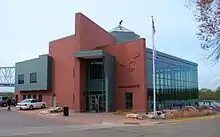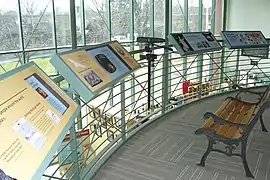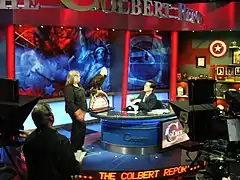National Eagle Center
The National Eagle Center is a nonprofit educational, interpretive center located on the banks of the Mississippi River in Wabasha, Minnesota, United States, that focuses on education about eagles and the Upper Mississippi River watershed. In addition to opportunities to view wild eagles throughout the year from viewing decks, non-releasable bald eagles and golden eagles are on exhibit at the center as well as interactive exhibits on eagle science and history.[2][3]
 | |
 | |

| |
| Established | 1995 |
|---|---|
| Location | 50 Pembroke Ave S. Wabasha, Minnesota, United States |
| Coordinates | 44.384441°N 92.031305°W |
| Type | Interpretive center |
| Visitors | 85,000 (2018) [1] |
| Director | Meg Gammage-Tucker |
| Website | www |
History
The site is located were hundreds of bald eagles congregate to scavenge and hunt fish year round due to a geographic anomaly at the confluence of the Mississippi and Chippewa Rivers. The Chippewa River's sedimentary deposits formed a delta creating Lake Pepin, a naturally occurring lake on the Mississippi formed by the backup of water. The fast running water exiting the Chippewa delta prevents ice from being able to form on the much of the Mississippi River in that area during the winter making it a good fishing ground for migrating eagles.[4][5]
In 1989, an informal group of local volunteers called Eagle Watch led by Mary Rivers partnered with the Wabasha Chamber of Commerce to develop an abandoned deck built for paddleboats to disembark passengers on the river for eagle enthusiasts coming to see bald eagles. In their first year of operation they tallied more than a thousand people who showed up in the middle of winter to look at bald eagles.[6][7]
In 1995, EagleWatch incorporated as a nonprofit and worked with the City of Wabasha which functioned as the fiscal agent for both State and Federal funds. The National Eagle Center received Federal recognition in 1998 which cleared the way for the U.S. Army Corps of Engineers, the Fish and Wildlife Service and other agencies to assist in its development.[8] The City of Wabasha later dropped its cooperative venture with EagleWatch to manage the Eagle Center, partnering instead with the National Audubon Society. In June 1999 the City of Wabasha contracted with the National Audubon Society to take over operations of the National Eagle Center from EagleWatch for eighteen months but later declined to renew the contract and "severed the ties" when it was discovered that most of the membership fees and donations raised were going to the support the National Audubon Society's State and National programs rather than to the National Eagle Center. The City was also alarmed over the National Audubon Society's decision to change the vision of the project substantially. The City of Wabasha then resumed its partnership with EagleWatch to take over the management of the National Eagle Center in July 2001.[9][10]
In 2000, under its then executive director Mary Beth Garrigan, the National Eagle Center opened a temporary year-round interpretive center in downtown Wabasha in a storefront building that formerly housed a bar. The center included two live permanently injured and non-releasable bald eagles, named Harriet and Angel.[11][12]
On May 2007, in a partnership with the City of Wabasha, the National Eagle Center opened 14,200-square-foot (1,320 m2) interpretive center on the banks of the Mississippi River on the site of the Big Jo Flour Mill at the corner of Pembroke Avenue and Lawrence Boulevard in Wabasha. The facility, designed by LHB, Inc., includes a living aviary, environmental and cultural exhibits, classrooms, auditorium, indoor and outdoor viewing space, and gift shop. In its new building the National Eagle Center provides programming on Environmental Stewardship, Native American history, the culture of the region, and the important symbolic role of the bald eagle in the American military.[13][14][15]
Future Expansion Plans
In 2016 the National Eagle Center revealed plans for a 15,000-square-foot expansion that would incorporate four historic buildings next to its existing structure in addition to adding an outdoor amphitheater, and more room to take care of the center's captive eagles. The expansion will also include additional gallery space to accommodate items from the Preston Cook Collection, over 25,000 items of art and artifacts depicting the eagle in American culture. Artworks include an original 1830s prints by naturalist and artist John James Audubon and Andy Warhol's 1983 bald eagle print.[16][17][18]
Facilities
Aviary and Eagles
The National Eagle Center, which houses both permanently injured and non-releasable bald and golden eagles call their resident eagles "ambassadors." The eagles are housed in a climate-controlled interior aviary with glass panels that allow visitors to watch the eagles from a distance. Visitors are also able to enter the aviary when permitted. Approximately forty-five minute educational, and entertaining feeding programs are often given three times each day at 11 am, 1 pm, and 3 pm providing visitors with another opportunity to learn about the eagle, as well as participate in question and answer sessions.[19][20]
Bald eagles
- Angel - Found on the ground with a broken wing near Grantsburg, WI 1999. Arrived at the Center in 2000.
- Columbia - Injured in a vehicle collision that fractured her right shoulder and was found to have nearly twice the lethal dose of lead in her blood. Arrived at the Center in 2003.
- Was'aka - Blind in his left eye due to a tumor, since removed. Arrived at the Center in 2009.
- Latsch - Blind in his left eye. Was found in the summer of 2016 on the ground. Arrived at the Center in 2018.
Past Eagle Ambassadors
Bald eagle
- Harriet - The first eagle ambassador and arrived at the National Eagle Center in 2000. A vehicle collision in 1998 left her left wing badly dislocated and was partly amputated. Harriet passed away in May of 2016 at the age of 35.[21]
Golden eagle
- Donald - Hit by a car and his right wing was broken in two places. Arrived at the Center in 2008. He passed away on March 16, 2020 due to suspected complications of a stroke.
Native American Artifact Exhibit
An "object theater" features ancestral artifacts of the late Jim Stokes, a descendant of Chief Wapasha III and an active supporter of the Eagle Center. The objects are in a darkened room, when people are present, a light over an item will comes on and the recorded voice of Stokes provides information on the object, then the light will dim and another will activate featuring another object.[22]
Observation Decks
The facility provides an exterior 25' high deck, as well as a river-level deck for viewing bald eagles complete with spotting scopes provide opportunity to view wild eagles over the adjoining Mississippi River and backwaters, as well as river traffic and other species of wildlife.
Other Facilities
- Classrooms, lecture facilities and community gathering area
- Exhibit areas to allow a variety of exhibits
- preserved animal specimens
- preserved birds in flight
Events
SOAR with the Eagles
SOAR With the Eagles is an annual festival celebrating the Bald Eagle spring migration along the Mississippi River. Visitors enjoy a variety of special programming at the Center. The festival includes, but is not limited to, wild eagle viewing, animal presentations, flying bird shows, special exhibits, and educational programs.[23]
Directors
Gallery
References
- "https://www.guidestar.org/profile/41-1817466". www.guidestar.org. Retrieved 2020-01-18. External link in
|title=(help) - "National Eagle Center, Wabasha | MNopedia". www.mnopedia.org. Retrieved 2020-01-18.
- "Minnesota museum tours to take". Star Tribune. Retrieved 2020-01-18.
- Fremling, Calvin (2004). Immortal River: The Upper Mississippi in Ancient and Modern Times. University of Wisconsin Press. pp. 85–86. ISBN 978-0-299-20294-1.
- "Lake Pepin". Minnesota Department of Natural Resources. 2009-11-18. Retrieved 2020-01-18.
- "How the National Eagle Center took flight in Wabasha". Twin Cities. 2019-06-29. Retrieved 2020-01-18.
- btodd@postbulletin.com, Brian Todd. "National Eagle Center ready to hatch next big step". PostBulletin.com. Retrieved 2020-01-18.
- "Both sides proclaim budget victory: Details of the agreement". Star Tribune. October 16, 1998. p. 1A.
- White, Ruby (June 27, 2001). "Eagle Center breaks ties with Audubon Society". Wabasha County Herald. p. 1 and 2.
- "The Eagle is back And Wabasha plans special recognition". Star Tribune. July 7, 1999. p. 14A.
- Smith, Michael (August 2, 2000). "Grand Opening held for temporary home of the National Eagle Center". Wabasha County Herald.
- "How the National Eagle Center took flight in Wabasha". Twin Cities. 2019-06-29. Retrieved 2020-01-18.
- "National Eagle Center". LHB. Retrieved 2020-01-18.
- Smith, Mike (May 9, 2007). "The National Eagle Center: More than a building, this one has...a "soul'". Wabasha County Herald (5). Wabasha, Minnesota. pp. 1 and 3.
- Jun 1st 2007 - 12am, Red Wing Newsroom |. "National Eagle Center opens in Wabasha". RiverTowns. Retrieved 2020-01-18.
- www.bizjournals.com https://www.bizjournals.com/twincities/blog/real_estate/2016/05/national-eagle-center-plans-new-wing.html. Retrieved 2020-01-18. Missing or empty
|title=(help) - btodd@postbulletin.com, Brian Todd. "National Eagle Center ready to hatch next big step". PostBulletin.com. Retrieved 2020-01-18.
- "Collection". American Eagle Collection. Retrieved 2020-01-18.
- Center, National Eagle (2014-09-12). "Our Eagles". National Eagle Center. Retrieved 2020-01-19.
- Schmitz, Rob (2003-01-16). "Eagle Center considers its future". Minnesota Public Radio. Retrieved 2007-09-05.
- "Meet Our Eagles". National Eagle Center. Retrieved 2020-08-05.
- Jun 1st 2007 - 12am, Red Wing Newsroom |. "National Eagle Center opens in Wabasha". RiverTowns. Retrieved 2020-01-19.
- McLernon, Lianna Matt (2019-03-20). "SOAR with the Eagles". Minnesota Monthly. Retrieved 2020-01-19.
- Smith, Michael (February 23, 2000). "Eagle Center hires Exec. Director". Wabasha County Herald.
- Red Wing Newsroom (May 22, 2012). "Business notebook: National Eagle Center introduces new director". RiverTowns. Retrieved 2020-01-18.
- btodd@postbulletin.com, Brian Todd. "'I check on the birds every day': National Eagle Center welcomes new CEO". PostBulletin.com. Retrieved 2020-01-18.
External links
- National Eagle Center in MNopedia, the Minnesota Encyclopedia
- National Eagle Center - official site
- Preston Cook Collection of American Eagle memorabilia




